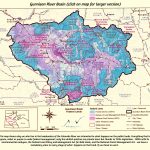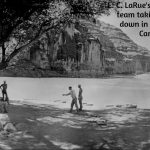
To summarize the last three posts on this site – we have been looking at the generally ambiguous relationships between the United States federal government, the seven not-very-united states in the Colorado River region, and 30 recognized First People nations who inhabit the Colorado River Basin. The 30 nations, still primarily using Stone Age technology, were overrun, conquered and thoroughly dominated by the global Holocene expansion of European peoples with much superior technology and firepower – plus some nasty diseases that moved out ahead of the invaders, eliminating maybe as much as two-thirds or three-fourths of the First People populations.
The overrunning of the First Peoples was not done through any long-standing animus, as against ancient enemies; the hundreds of First People nations were just in the way. The Euro-Americans came in waves of ‘settlers’ who wanted to settle in and farm the land, and ‘unsettlers’ who wanted to rip into the land for the minerals, trees, grasses and waters that were the substance of a kind of wealth. To their ostensibly civilized perspective, the First Peoples wandering over those landscapes hunting and gathering what they could under a policy of usufruct (own the fruits but not their sources) were inefficient wastrels.
The spectrum of options for getting the post-pandemic remnant First Peoples off the land ranged from just killing them all – never really the official policy, although it was a practice mostly excused when the lunatic fringe took that bit in their teeth – to finally concentrating First Peoples forcibly on out-of-the-way reservations that were a fraction of their former land, or maybe even moving them on to a new place beyond the settlement frontier, thus freeing up most or all of their former land for the settlers and unsettlers of the ever-expanding urban-industrial civilization.
This reservation policy was accomplished under the guise of a paternalistic ‘trust’ arrangement, whereby the government would provide the supplies and education for ‘civilizing’ the First Peoples – ultimately a process of forced assimilation: ‘kill the Indian’ modified to ‘kill the Indian culture to save its people.’ This was often carried out through official policies like breaking the reservations up into individual allotments to teach a proper European respect for private property; it was also contracted to zealous faith-based organizations collecting souls for Jesus, and private sector suppliers collecting wealth for themselves, resulting in practices like pretty literally starving the First Peoples’ communal cultures on the reservation, and removing all the children to boarding schools where they were force-fed Christian-industrial culture.
These practices prevailed more or less unchallenged into the 1960s, until the Second People began to take a deeper look at their own consequences on the land, where the finally unignorable and increasingly deadly ‘smell of money’ – the air and water pollution, the forest-land erosion, the hidden or buried barrels of chemical wastes, all excused as the unavoidable consequences of wealth generation – caused growing doubts about the manifested destiny of the American way. And that led to a growing interest in exploring alternatives, including nostalgic reflections on Indian ways. The limited success of the American Indian Movement of the late 1960s and 1970s probably depended more on popular support from the Second People than from the First Peoples themselves.
Many of the reservations remain impoverished messes today – rural slums with high unemployment, high drug and alcohol abuse, domestic violence, physical and mental health challenges, and a general air of hopelessness and despair. At best the paternalist trust relationship has mostly been an embarrassment of inattention and indifference; at worst it has been at least passively corrupt, allowing leasing to outside companies of resource development on the reservations with little oversight, poor bookkeeping and wrongful diversion of funds, cheating the First Peoples out of billions in royalties.
Nonetheless, at this point in time, I think it can be said that most of the remaining 700-plus First Peoples in the United States have survived the centuries of efforts to kill their cultures – and have survived as still culturally distinct ‘nations.’ Their spiritual, economic and political heritages have been modified in many respects by the global overwhelm of industrial culture everywhere, but they are still relatively small and tight communal societies with internal spiritual bonding that helps them to resist some of the pressures of the mass society and industrial culture. The most successful tribal nations have taken control of their own futures (and resources), and become successful as much in spite of as on account of their Great Father trustees.
There’s probably no better example than the Southern Ute People, descendants of the Muache and Capota Ute bands who had ranged over the southern San Juan mountains and the San Juan River basin, but were finally confined around the turn of the 20th century to a 75 mile by 15 mile reservation in the extreme southwestern corner of Colorado. The Utes were one of the First Peoples who had responded to the Holocene ‘trauma of success’ – population growth and its pressure on traditional territories – by rejecting the turn toward farming (defensive concentration of food supplies), and instead had chosen to fight for their hunter-forager way of life, pitting their bands against bands of Comanches and Apaches, and Navajos after they arrived, who also rejected the conversion to farming – and then against the Spanish when they tried to move into El Norte, and finally against the mass of Euro-Americans moving westward.
Once they had stolen or otherwise ‘found’ the Spanish horses, these retro hunter-foragers developed a serious warrior culture, raiding and terrorizing the farming Peoples, and the Spanish land-grant settlers. But their main battles appear to have been against each other, all wanting to expand their old territories into each other’s territories; they often formed shifting alliances to gang up on each other.
Only the massive unstoppable wave of Euro-Americans from the east – the U.S. Army first, backed by the army of settlers and unsettlers – managed to gradually wear down, contain and eventually confine the remnants of the warrior Peoples to reservations. The Ute reservation for all their bands went from basically everything west of the Continental Divide in an 1850s agreement through several shrinking short-lived ‘in perpetuity’ treaties, to the small strip of land in southwestern Colorado for the Muache and Capota bands, an even smaller adjacent block of land (Ute Mountain Ute Reservation) for the Wiemenuche band, and the Uintah and Ouray Reservation in eastern Utah for all the northern Ute bands. The Southern Utes today have a total tribal membership between 1,500-2,000, with about two-thirds living on the reservation; the Ute Mountain Utes have around 2,000 members, about half on the reservation; the Uintah Reservation is home for about half the tribal membership around 3,000.
The Southern Ute Reservation, however, turned out to be one of those pieces of worthless land given to the First Peoples that had significant resources hidden underground – fossil fuels, mostly natural gas and coalbed methane. In its paternalistic way – the Great Father from Washington taking care of his children – the Bureau of Indian Affairs began leasing access to those resources to outside interests, collecting royalties they then distributed to the members of the tribe – sums on the order of $1,000 a year plus or minus.
But the Southern Utes still had enough of their fighting spirit to question the accounting of the companies and the BIA’s oversight on the companies, and in the 1960s, in the spirit of the American Indian Movement, they set about taking control of the development of the reservation’s resources themselves, under the leadership of tribal chairman Leonard Burch. I haven’t the space here to give a detailed account of how the Southern Ute People did that; Jonathan Thompson did a good job of that in a High Country News article, for those interested in pursuing it further.
Suffice it to say, over the decades since Burch’s leadership, the tribal council has succeeded in taking control of the People’s destiny, with help from friends among the Second People – notably a Durango attorney, Sam Maynes, and his protege Tom Shipps who still works with the tribe, as well as a number of hired consultants and managers with experience in the gas industry. A lawsuit against the government by the neighboring Jicarilla Apaches established a tribal right to negotiate directly on royalties with the outside companies – which quickly resulted in the Southern Utes discovering that the companies had been shorting the tribe, with lackadaisical oversight from the BIA as the most charitable explanation.
Then in the 1990s, the council decided there was no reason they couldn’t do as well as the outside companies in developing their own resources, again with a little help from knowledgeable outsiders, and they set up the Red Willow Production Company to put tribal members to work drilling and piping for new wells; they began buying up existing wells, and created Red Cedar Company to ‘gather’ their produced gas and get it into the regional distribution pipelines.
This became a big enough business so it was becoming a bit hamstrung by being run by the tribal council, which as a democratic body, changed members frequently, and had too many other responsibilities to be also managing a growing corporate structure, so Red Willow was set up as a separate corporation, owned by the tribe but free to operate as an independent business with ultimate tribal council oversight. Its substantial earnings were divided between two funds: a Growth Fund under management of the corporation, and a Permanent Fund administered by the tribal council, essentially an endowment generating income from investment sufficient for tribal community governance. The Growth Fund pays annual dividends to every tribe member aged 26-59 and retirement benefits for those over 60 – substantially larger payments than the $1,000 plus or minus under BIA administration. The tribe gives out no information on the sums, but bits of information picked up by Thompson in his research put them in the middle tens-of-thousands of dollars. The Permanent Fund builds medical facilities and provides health care for the people. The Utes believe education is important and take schools seriously; they like the Montessori system for their young children. But they are still – or maybe it’s once again, with no ‘trustee’ resistance – raising the children as Utes, learning the language and doing the annual Bear Dance and other traditional festivals with the adults. And – sustaining a cross-cultural balance – anyone who wants to go to college gets a full-ride scholarship.
Realizing that they wanted to sustain the tribe well beyond the depletion of their unsustainable gas reserves, Growth Fund earnings beyond the direct distribution to the People are being invested in a variety of other activities, including oil and gas production on other reservations, a substantial investment in deepwater drilling in the Gulf of Mexico, a wide range of real estate investments as far away as San Diego, and a private equity division that buys struggling companies to improve them (one hopes, rather than gutting them) and resell them. It is also into some more exploratory environmental things like carbon-reduction forest restoration work in the area’s ponderosa stands (part of the reservation extends into San Juan National Forest), using new technology to shred rather than burn thinned biomass and mixing it with sludge from sewage plants, creating a compost to return to the land; the tribe hopes that this plus some other strategies will help move them toward carbon-neutral status.
There is a minority in the tribe that worries that the Red Willow Production corporation is taking a turn toward the dark side – too much investment in gas and oil at a time when an environmental sensibility argues that responsible governments should be cutting back on that and investing in renewables. And the practices of private equity organizations have generally earned a bad reputation among anyone concerned about true cultura; equity. Is the tribal council still really in control, or is the tail wagging the dog? Our mainstream American experience of being politically and economically dominated by too-big corporations suggests that’s a question the Southern Utes should confront soon.
Still – anyone with a true democratic sensibility cannot look at this melding of First People communal culture and 20th-century industrial capitalism without a twinge of longing. The Southern Utes have a true ‘commonwealth’ – the land is a commons and its wealth belongs to everyone on the land. Those who work for Red Willow or the tribal government obviously get paid according to their level of responsibility and skill, above and beyond the Growth Fund dividends, but the dividends provide a well-woven safety net, their helth care is not an impenetrable mess, and no one has to assume a lifetime debt to get the education they need to pursue their personal vision.
One tries to imagine what we might be today if we had not allowed a comparative handful of We the People to keep almost all of the wealth extracted from the nation’s commons, but had instead invested it in We the People through a Ute-like form of social capitalism rather than mainstream American private capitalism…. One wonders, at this point, who should be learning civilized living from whom.
But – where’s the water, the river that runs through it all? Next time back to that – another problem of western living in which the Utes look pretty good.
Civilized means citified, trained, faithful to some regimen deliberately instituted.
Civilization might be taken as a purely descriptive term, like Kultur,
rather than a eulogistic one; it might simply indicate the possession of instruments,
material and social, for accomplishing all sorts of things,
whether those things were worth accomplishing or not.
– George Santayana,
‘Marginal Notes on Civilization in the U.S.’




My favorite essay so far. Thank you !
Thanks again, George. Informative and provocative and very reflective of my own experience with First People. Most with whom I have dealt in the Pacific Northwest have pretty much claimed back their heritage, but a lot of damage was done in the interim, especially with respect to tribal culture among young people. The Northwestern experience was mostly about fishing rights which, while important, does not rise to the prominence of below ground mineral wealth. The key to success, such as they had, was in retaining sovereignty to the land, not in a questionable quest for “civil rights.” I need to find out more about these matters closer to home in New Mexico where some of the pueblos I drive by every week have been established for hundreds of years.
That’s a rich region to explore, probably with ties back to things that didn’t work so well over in the Colorado River Basin….
Thanks for this education George. It is good to know that the Southern Utes have become so self determined.
I think of Einstein’s quote: (sorry, I have to paraphrase this) “We cannot solve a problem using the same thinking that created the problem.”
I had never heard the term “social capitalism” before. It mitigates the idea of capitalism being the great evil. And I do think there is potential for this way of doing after the paradigm shift to a more consciousness oriented society. But I am also of the persuasion that real change requires real change.
Just my 2 cents worth…😊
Yessirree George! THe sad story you tell is really part of the human saga that is unfolding. THe “First peoples” (though not the first by any means, but the first here). essentially the pre-civilized societies like in our initial species state, i.e. hunters and gatherers—— but a Society. We now are, unknowingly for the most part, in the process of going back to an unknown, but inevitable state something like theirs. They lived in and on the land and within the land limits. How to keep some of the goodies of civilization but still learning to live within limits (forever) is the coming existential job over the next millennium. The First Peoples should have a large say in the final outcome.
This taught me so much about the Southern Utes, and I’m fascinated by their preference for the Montessori educational technique.
We enjoyed a program in Hotchkiss, Colorado, on Saturday, ‘Remembering Our First Peoples Kind of Place.’ Sally Crum was our speaker, and her comments sync very closely with your comments here. Enjoyed both of your presentations very much!